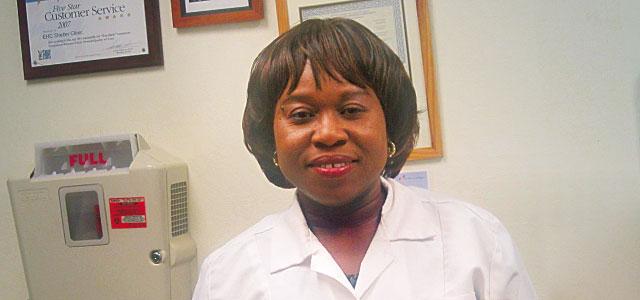
Mercy Egbujor, NP, associate clinical professor
What Volunteer Clinical Faculty Do: Mercy Egbujor Cares for the South Bay’s Homeless
Volunteer clinical faculty and preceptors offer students individual perspectives and hands-on experience in a variety of health care settings and specialties. The cumulative effect of what these volunteers impart plays a significant role in the care any health system delivers. This series aims to shed light on the unique roles these valuable mentors play.
This month we hear from Mercy Egbujor, an associate clinical professor with UCSF School of Nursing. She also works as a family nurse practitioner, directing care for the Santa Clara Valley Homeless Healthcare Program (VHHP) through Santa Clara Valley Medical Center.
To pay my way through college, I worked as a nurse’s aide at Santa Clara Valley Medical Center in San Jose. While working as a nurse’s aide, I realized that I liked nursing better than what I was studying, so when I graduated from San Jose State University, I went to De Anza College in Cupertino (California) and got my registered nurse (RN) license and an associate degree in nursing.
After working as an RN in med-surg (also at Santa Clara Valley Medical Center) for seven years, I went back to school to get my master’s degree in nursing through the bridge program at California State University, Dominguez Hills. I completed my family nurse practitioner specialization in 2000; and in 2001, Valley Medical Center hired me as a nurse practitioner. Since then, I’ve worked primarily with the homeless, through the Santa Clara Valley Homeless Healthcare Program (VHHP), which is a federally qualified outpatient clinic run by Valley Medical Center.
When I started, I was the only full-time provider for the homeless program, along with a licensed vocational nurse and my supervising physician, who wasn’t on-site. I provided primary care to the homeless five days a week at Valley Medical Center’s Homeless Shelter Clinic inside EHC LifeBuilders (formerly the Emergency Housing Consortium), the largest homeless shelter in Santa Clara County, also known as “Little Orchard.”
Since we’ve been federally qualified and received some more grants, we’ve grown into a team of 29 people, including medical doctors, psychiatrists, psychologists, medical social workers, registered nurses, medical assistants, registration clerks and outreach workers.
Three and a half days per week, I provide primary care at Little Orchard, along with my main charge nurse and our medical assistant. I also work at the Valley Homeless Clinic at Alexian Drive in San Jose, alongside many wonderful, dedicated and caring clinicians and staff, providing primary care to the homeless population. In collaboration with our medical respite director, I also provide primary care services on a walk-in basis to homeless in Santa Clara County, as well as patients who are discharged from local hospitals to our medical respite program for the homeless.
When I’m not at the shelter or the clinic, I’m in our mobile medical van, which is one of the most important parts of the program because it reaches people who can’t come to the shelter or clinic. We strive to reach out to our homeless patients wherever we can because many of our patients have mental illness and drug or alcohol addiction, problems that make it difficult for them to assimilate into a public place.
Once a week, we take the van to what we call Coyote Creek, where homeless people live in encampments. Some of them don’t want to come out, no matter how sick they are, so our outreach coordinator and our psychologist go down by the creek to bring them to the van. We’re usually able to see from 8 to 12 people per day. We provide an integrated team approach in caring for the homeless at the creek encampments, and we recently presented our program at the International Street Medicine Symposium, in Salt Lake City.
There are some unique challenges to working with a homeless population. A lot of patients have mental illness, but many don’t realize it. There’s a lot of uncontrolled diabetes, high blood pressure, and alcohol and drug abuse; many homeless are just in a survival mode, so health is not a priority unless they get sick. If it’s an emergency, they go to the emergency department, but if they can, they will wait to see us at the clinic.
I first went to the homeless clinic for a rotation when I was a student, and I like having students rotate through our clinic because I think they should have an opportunity to see what life is like for homeless people – and to learn how they as nurse practitioners can make a difference. For example, when you’re writing a prescription for a homeless patient, if you say, “Take your medicine with food,” you need to consider where the patient is going to get that food.
At UCSF, Hattie Grundland has been my contact for years, and we’ve developed a partnership. I usually take three students a year from UCSF, at different stages of their education, from first semester to third semester, so they have different learning requirements. Hattie provides me with their learning objectives, and I teach them based on where they are.
I enjoy having students. They bring a lot of knowledge and passion to their work. They learn a lot in the classroom, but they need a place to be able to integrate what they’ve learned, and my job is to provide them with hands-on practical experience. For example, I may start them off doing some teaching with patients on hypertension or diabetes. The first-semester students also need a lot of work on history taking and learning how to organize their thought processes.
I’d like to do more teaching eventually, and that’s one reason I’ve gone back to school to get my doctor of nursing degree. I love learning; if you’re going to remain relevant, you have to keep learning and advancing your knowledge base.



